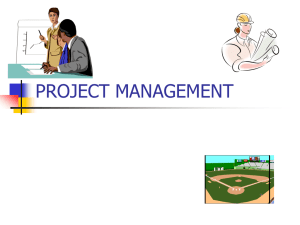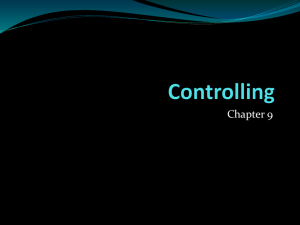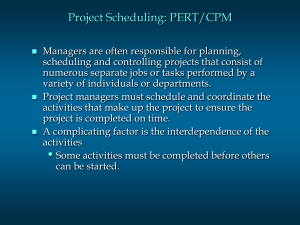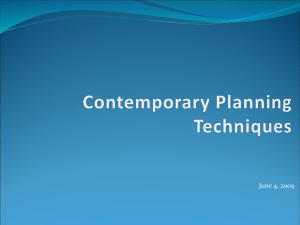Project Times
advertisement
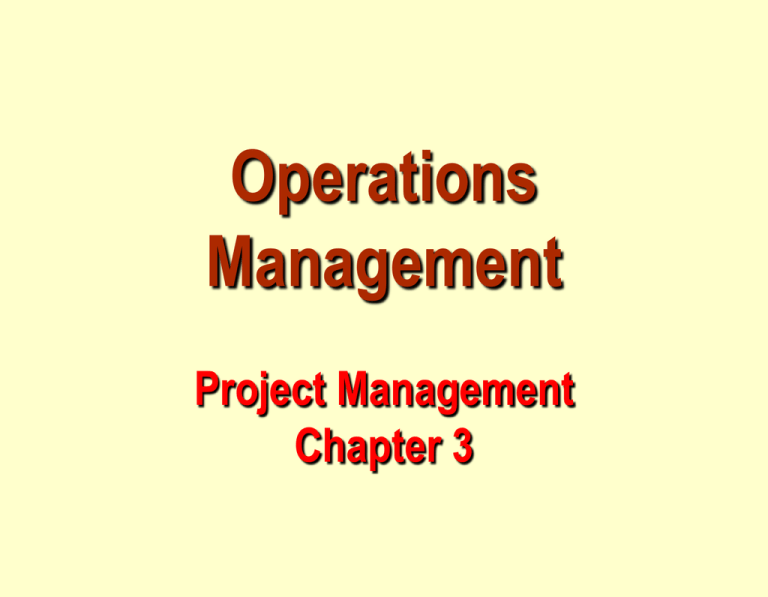
Operations Management Project Management Chapter 3 Reference Text Books (參考書籍) 1) Harold Kernel (2003), “Project Management, a system approach to planning, scheduling, and controlling” Eighth Edition, Wiley. (1) Heung Suk Hwang (2004), “R&D Project Management Software and Its Application”, Chung Moon Gak Co. (2) 管 孟忠 (2004), “策略專案管理金字塔(Project Management Pyramid)”, 博項策略顧問役扮有限公司. (3) Reference Papers and Softwares. Department of Business and Administration Author : 黃 興錫 No of Page : 340 pp ISBN : 889-7088-855-1 Publish Co. : Chung-Mun Gak Co. Day of Publish : 2004. 2. 25 This book was published for Project Management theory and also SW for practical uses and also have shown some of practical example problems. 1) Project scheduling, PERT/CPM and its web-based computer programs with its application samples. 2) For the evaluation of projects from the alternative development, evaluate these alternative, and integration of individual evaluation results, we propose a three-step evaluation model and with SW. This text book can be well used in university course work and also in practical problems for project managers. Department of Business and Administration Department of Business and Administration Outline GLOBAL COMPANY PROFILE: BECHTEL GROUP THE IMPORTANCE OF PROJECT MANAGEMENT PROJECT PLANNING The Project Manager Work Breakdown Structure PROJECT SCHEDULING PROJECT CONTROLLING Outline - Continued PROJECT MANAGEMENT TECHNIQUES: PERT AND CPM The Framework of PERT and CPM Network Diagrams and Approaches Activity on Node Example Determining the Project Schedule Forward Pass Backward Pass Calculating Slack Time and Identifying the Critical Path(s) Outline - Continued Variability in Activity Times Three Time Estimates in PERT Probability of Project Completion Cost-Time Tradeoffs and Project Crashing A Critique of PERT and CPM Visual PERT/CPM Computer Program Practice Learning Objectives When you complete this chapter, you should be able to : Identify or Define: Work breakdown structure Critical path AOA and AON Networks Forward and Backward Passes Variability in Activity Times Learning Objectives - Continued When you complete this chapter, you should be able to : Describe or Explain: The role of the project manager Program evaluation and review technique (PERT) Critical path method (CPM) Crashing a project The Use of MS Project Bechtel Asked by Kuwait to begin rebuilding after Desert Storm 650 wells ablaze, others uncapped No water, electricity, food or facilities Land mines! Bombs! Grenades! Many fires inaccessible because of oil-covered roads Bechtel Project required: Storage, docking, and warehousing facilities at Dubai 125,000 tons of equipment and supplies 150 kilometers of pipeline capable of delivering 20,000,000 gallons of water per day to the fire site more than 200 lagoons with 1,000,000 gals of seawater Bechtel Other Projects Building 26 massive distribution centers in just two years for the internet company Webvan Group Constructing 30 high-security data centers worldwide for Equinix, Inc. Building and running a rail line between London and the Channel Tunnel ($4.6 billion) Developing an oil pipeline from the Caspian Sea region to Russia ($850 million) Expanding the Dubai Airport in the UAE ($600 million), and the Miami Airport in Florida ($2 billion) Bechtel Other Projects - Continued Building liquid natural gas plants in Yemen $2 billion) and in Trinidad, West Indies ($1 billion) Building a new subway for Athens, Greece ($2.6 billion) Constructing a natural gas pipeline in Thailand ($700 million) Building a highway to link the north and south of Croatia ($303 million) Strategic Importance of Project Management Bechtel Kuwait Project: 8,000 workers 1,000 construction professionals 100 medical personnel 2 helicopter evacuation teams 6 full-service dining halls 27,000 meals per day 40 bed field hospital Strategic Importance of Project Management - Continued Microsoft Windows XP Project: hundreds of programmers millions of lines of code millions of dollars cost Ford Redesign of Mustang Project: 450 member project team Cost $700-million 25% faster and 30% cheaper than comparable project at Ford Project Characteristics Single unit Many related activities Difficult production planning and inventory control General purpose equipment High labor skills An Example Building construction © 1995 Corel Corp. An Example Research project © 1995 Corel Corp. Management of Large Projects Planning - goal setting, project definition, team organization Scheduling - relating people, money, and supplies to specific activities and activities to one and other Controlling - monitoring resources, costs, quality, and budgets; revising plans and shifting resources to meet time and cost demands Project Management Activities Planning Objectives Resources Work breakdown schedule Organization Scheduling Project activities Start & end times Network Controlling Monitor, compare, revise, action Project Organization Works Best When Work can be defined with a specific goal and deadline The job is unique or somewhat unfamiliar to the existing organization The work contains complex interrelated tasks requiring specialized skills The project is temporary but critical to the organization Project Planning, Scheduling, and Controlling Project Planning 1. Setting goals 2. Defining the project 3. Tying needs into timed project activities 4. Organizing the team Time/cost estimates Budgets Engineering diagrams Cash flow charts Material availability details Project Scheduling 1. Tying resources to specific activities 2. Relating activities to each other 3. Updating and revising on a regular basis CPM/PERT Gantt charts Milestone charts Cash flow schedules Project Controlling 1. Monitoring resources, costs, quality, and budgets 2. Revising and changing plans 3. Shifting resources to meet demands Before Project During Project Reports • budgets • delayed activities • slack activities Project Planning, Scheduling, and Controlling Project Planning Establishing objectives Defining project Creating work breakdown structure Determining resources Forming organization © 1995 Corel Corp. Project Organization Often temporary structure Uses specialists from entire company Headed by project manager Coordinates activities Monitors schedule & costs Permanent structure called ‘matrix organization’ Eng. Acct. Eng. Mkt. Mgr. © 1995 Corel Corp. A Sample Project Organization President Sales Finance Project 1 Project Manager Project 2 Human Resources Engineering Quality Control Production Physiologist Propulsion Engineer Test Engineer Technician Psychologist Structural Engineer Inspection Technician Technician Project Manager A Sample Project Organization President Human Resources Sales Project 1 Project 2 Finance Project Manager Project Manager Engineering Quality Control Production Propulsion Engineer Test Engineer Technician Structural Engineer Inspection Technician Technician Matrix Organization Mkt Project 1 Project 2 Project 3 Project 4 Oper Eng Fin The Role of the Project Manager Project Plan and Schedule Revisions and Updates Project Manager Information regarding times, costs, problems, delays Resources Performance Reports Project Team Feedback Loop Top Management Work Breakdown Structure 1. Project 2. Major tasks in the project 3. Subtasks in the major tasks 4. Activities (or work packages) to be completed Project Scheduling Identifying precedence relationships Sequencing activities Determining activity times & costs Estimating material & worker requirements Determining critical activities © 1995 Corel Corp. Purposes of Project Scheduling Shows the relationship of each activity to others and to the whole project. Identifies the precedence relationships among activities. Encourages the setting of realistic time and cost estimates for each activity. Helps make better use of people, money, and material resources by identifying critical bottlenecks in the project. Project Management Techniques Gantt chart Critical Path Method (CPM) Program Evaluation & Review Technique (PERT) © 1984-1994 T/Maker Co. Gantt Chart Activity Design Build Test Time Period J F M A M J J Service Activities for A Delta Jet During a 60 Minute Layover Project Control Reports Detailed cost breakdowns for each task Total program labor curves Cost distribution tables Functional cost and hour summaries Raw materials and expenditure forecasts Variance reports Time analysis reports Work status reports PERT and CPM Network techniques Developed in 1950’s CPM by DuPont for chemical plants (1957) PERT by Booz, Allen & Hamilton with the U.S. Navy, for Polaris missile (1958) Consider precedence relationships and interdependencies Each uses a different estimate of activity times Questions Which May Be Addressed by PERT & CPM Is the project on schedule, ahead of schedule, or behind schedule? Is the project over or under cost budget? Are there enough resources available to finish the project on time? If the project must be finished in less than the scheduled amount of time, what is the way to accomplish this at least cost? The Six Steps Common to PERT & CPM Define the project and prepare the work breakdown structure, Develop relationships among the activities. (Decide which activities must precede and which must follow others.) Draw the network connecting all of the activities Assign time and/or cost estimates to each activity Compute the longest time path through the network. This is called the critical path Use the network to help plan, schedule, monitor, and control the project A Comparison of AON and AOA Network Conventions Milwaukee General Hospital’s Activities and Predecessors Activity Description Immediate Predecessors A Build internal components - B Modify roof and floor - C Construct collection stack A D Pour concrete and install frame A, B E Build high-temperature burner C F Install pollution control system C G Install air pollution device D, E H Inspect and test F, G AON Network for Milwaukee General Hospital F A C F Start B D H G AOA Network (With Dummy Activities) for Milwaukee General 2 1 C Construct stack 4 Dummy Activity D 3 Pour concrete/ 5 Install frame 6 H Inspect/Test 7 Critical Path Analysis Provides activity information Earliest (ES) & latest (LS) start Earliest (EF) & latest (LF) finish Slack (S): Allowable delay Identifies critical path Longest path in network Shortest time project can be completed Any delay on critical path activities delays project Critical path activities have 0 slack Earliest Start and Finish Steps Begin at starting event and work forward ES = 0 for starting activities ES is earliest start EF = ES + Activity time EF is earliest finish ES = Maximum EF of all predecessors for nonstarting activities Latest Start and Finish Steps Begin at ending event and work backward LF = Maximum EF for ending activities LF is latest finish; EF is earliest finish LS = LF - Activity time LS is latest start LF = Minimum LS of all successors for nonending activities Latest Start and Finish Steps Latest Start LS Activity Duration ES Activity Name Earliest Start EF Earliest Finish LF Latest Finish Critical Path for Milwaukee General Hospital F A C F Start B D H G AON Network for Milwaukee General HospitalIncludes Critical Path A 0 H 2 0 A 2 2 Slack=0 0 HStart 0 0 0 0 BB Start 0 H 3 4 1 3 Slack=1 C 2 H 4 2 C4 2 Slack=0 DD 3 H 7 8 4 4 Slack=1 FF 4 H 7 13 10 3 E Slack=6 4 H 8 F 8 4 4 Slack=0 G 8 G H 13 13 8 5 Slack=0 H 13 H 15 15 13 2 Slack=0 Gantt Chart Earliest Start and Finish Milwaukee General Hospital 1 2 3 4 5 6 7 8 9 10 1112 13 1415 16 A Build internal components B Modify roof and floor C Construct collection stack D Pour concrete and install frame E Build high-temperature burner F Install pollution control system G Install air pollution device H Inspect and test Gantt Chart Latest Start and Finish Milwaukee General Hospital 1 2 3 4 5 6 7 8 9 10 1112 13 1415 16 A Build internal components B Modify roof and floor C Construct collection stack D Pour concrete and install frame E Build high-temperature burner F Install pollution control system G Install air pollution device H Inspect and test Gantt Chart Latest Start and Finish Build House Project Activity 1-2 Fdn & frame 1-3 Buy shrubs 2-3 Roof 2-4 Interior work 3-4 Landscape 1 1 1 1 2 3 4 5 6 7 8 9 0 1 2 PERT Activity Times 3 time estimates Optimistic times (a) Most-likely time (m) Pessimistic time (b) Follow beta distribution Expected time: t = (a + 4m + b)/6 Variance of times: v = (b - a)2/6 Project Times Used to obtain probability of project Sum of critical path activity completion! times, t Expected project time (T) Project variance (V) Sum of critical path activity variances, v PERT Probability Example You’re a project planner for General Dynamics. A submarine project has an expected completion time of 40 weeks, with a standard deviation of 5 weeks. What is the probability of finishing the sub in 50 weeks or less? © 1995 Corel Corp. Converting to Standardized Variable X - T 50 - 40 = = 2 .0 Z = s 5 Normal Distribution Standardized Normal Distribution sZ = 1 s =5 T = 40 50 X mz = 0 2.0 Z Obtaining the Probability Standardized Normal Probability Table (Portion) Z .00 .01 .02 sZ =1 0.0 .50000 .50399 .50798 : : : : 2.0 .97725 .97784 .97831 .97725 2.1 .98214 .98257 .98300 mz = 0 2.0 Probabilities in body Z Variability of Completion Time for Noncritical Paths Variability of times for activities on noncritical paths must be considered when finding the probability of finishing in a specified time. Variation in noncritical activity may cause change in critical path. Factors to Consider when Crashing The amount by which an activity is crashed is, in fact, permissible. Taken together, the shortened activity durations will enable one to finish the project by the due date. The total cost of crashing is as small as possible. Steps in Project Crashing Compute the crash cost per time period. For crash costs assumed linear over time: Crash cost per period (Crash cost Normal cost (Normal time Crash time ) Using current activity times, find the critical path If there is only one critical path, then select the activity on this critical path that (a) can still be crashed, and (b) has the smallest crash cost per period. Note that a single activity may be common to more than one critical path Update all activity times. Crash and Normal Times and Costs for Activity B Cost-Time Curves Used in Crashing Analysis Advantages of PERT/CPM Especially useful when scheduling and controlling large projects. Straightforward concept and not mathematically complex. Graphical networks aid perception of relationships among project activities. Critical path & slack time analyses help pinpoint activities that need to be closely watched. Project documentation and graphics point out who is responsible for various activities. Applicable to a wide variety of projects. Useful in monitoring schedules and costs. Limitations of PERT/CPM Assumes clearly defined, independent, & stable activities Specified precedence relationships Activity times (PERT) follow beta distribution Subjective time estimates Over-emphasis on critical path

